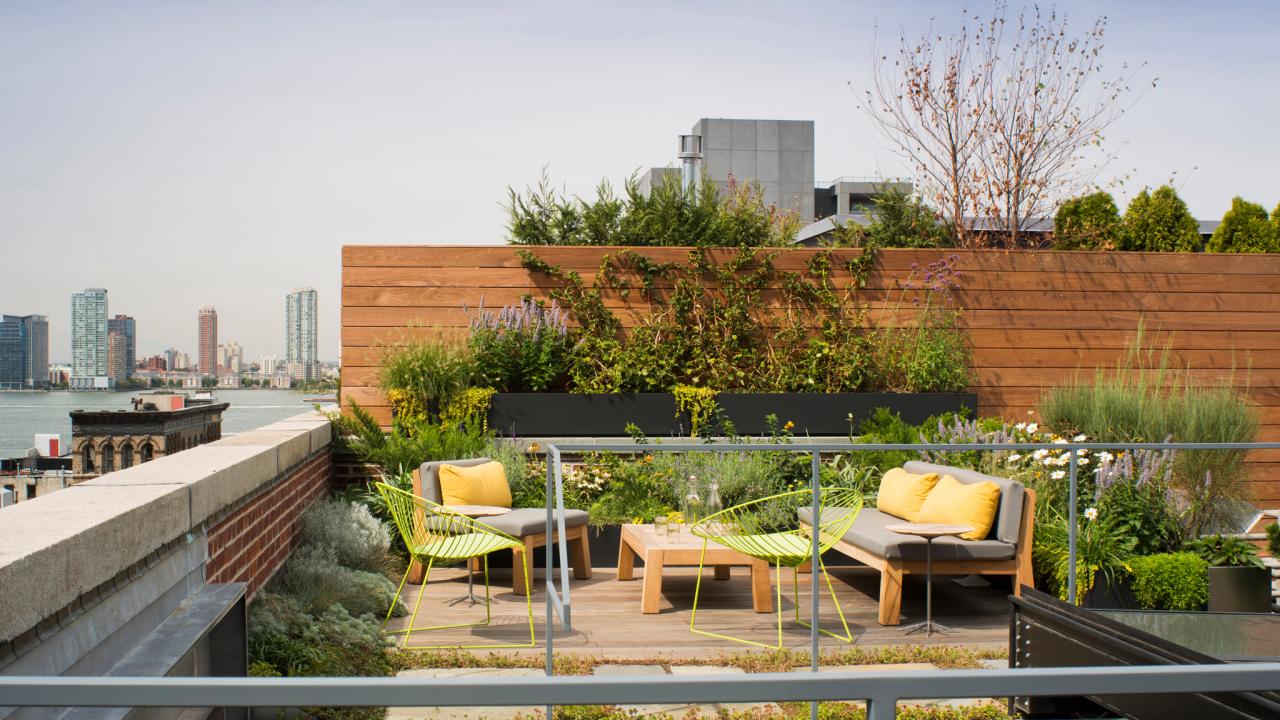Maximize your urban space with a rooftop garden, choosing compact, wind-tolerant plants and space-saving designs. Use lightweight containers and consider a drip irrigation system for easy watering.
Rooftop gardens offer an excellent solution for urban dwellers looking to embrace green living. They provide a unique opportunity for creating an oasis of tranquility amidst the hustle of city life. Clever use of space, appropriate plant selection, and innovative design can lead to a functional and beautiful retreat high above the streets.
Rooftop Gardening Ideas: Containers are key in a rooftop setting, allowing for flexibility in layout and planting. Opt for plants that can handle the elevated conditions, such as heightened exposure to sun and wind. Incorporating sustainable features like rainwater harvesting and solar-powered lighting can enhance the garden’s eco-friendliness. A well-planned rooftop garden not only contributes to the aesthetic value of your home but can also offer environmental and social benefits, turning a barren roof into a lush, inviting space.
Table of Contents
Embracing Urban Green Spaces
Creating your own rooftop garden is a fun way to enhance urban living. Start by choosing easy-to-maintain plants that can face the unique conditions rooftops bring. Think about using lightweight containers and soil mixtures designed for drainage and weight constraints. To maximize space, consider vertical planters or trellises for climbing plants.
Design with visibility in mind, incorporating levels and heights for more visual appeal. Break up the space with both edible and ornamental plants, like herbs and flowers. Make your rooftop an oasis with seating and shady areas. Check the sustainability of your structure with a professional before starting. Your garden will not only give you joy but also bring a slice of nature to the concrete jungle.
Designing A Thriving Rooftop Oasis
Creating a rooftop garden starts with understanding space and weight limits. Consult a professional to ensure your roof can support the garden. Measure your area to plan the layout. Use lightweight materials and consider a watering system.
Selecting climate-appropriate plants is crucial. For chilly areas, opt for hardy perennials. Warmer locations benefit from tropical plants. Succulents work well in most climates. They are drought-tolerant and low-maintenance.
| Plant Type | Benefits | Climate Suitability |
|---|---|---|
| Hardy Perennials | Survive winters | Cold |
| Tropical Plants | Lush and colorful | Warm |
| Succulents | Low water need | Most |
Maximizing Small Spaces For Big Impact
Container Gardening Tricks make the most of small rooftop spaces.
- Choose lightweight pots with drainage holes.
- Opt for soil-less potting mixes to reduce weight.
- Select varied pot sizes to create visual interest.
Remember, group plants with similar needs together.
Vertical Gardening Techniques save space and offer beauty.
| Type | Benefits |
|---|---|
| Trellises | Support for climbing plants |
| Wall Planters | Use walls for growing herbs and flowers |
| Hanging Baskets | Perfect for small flowers and fern |

Credit: www.rios.com
Combating Urban Heat Islands
Rooftop gardens significantly reduce urban heat effects. A layer of plants on a building absorbs sunlight, keeping rooftops up to 30℃ cooler. This planting layer acts as natural insulation. It keeps buildings warmer in winter and cooler in summer.
Green roofs can cut air-conditioning needs by over 75%. This leads to energy savings and lower utility bills. Plants on roofs also capture airborne pollutants and CO2. They make our air cleaner and our cities quieter.
Sustainability Up High
Eco-friendly materials are vital for rooftop gardens. Recycled plastics and wood, along with composite materials, make for durable, lightweight planters. Green rooftops prefer such materials as they are easier to move and are sustainable.
For water conservation, consider a drip irrigation system. This method is efficient and saves water. Collecting rain in barrels is another smart strategy. Plants that need less water, like succulents, are great choices. With these plants, rooftops stay green with less water.
| Material | Type | Benefits |
|---|---|---|
| Recycled Plastics | Planters | Lightweight, Durable |
| Composite Materials | Pots | Eco-Friendly, Easy to Handle |
| Collected Rainwater | Water Source | Conserves Water, Cost-Effective |

Credit: www.hgtv.com
Dining Among The Flowers
Transform your rooftop into a lush kitchen garden and dine surrounded by nature. Begin by choosing the right containers that fit your space and style. Opt for durable materials like wood or plastic, ensuring they have proper drainage.
Select herbs and vegetables that thrive in your climate and have similar sunlight and water needs. Some excellent choices include:
- Tomatoes: A rooftop favorite for their variety and usability.
- Peppers: Ranging from sweet to hot, ideal for diverse dishes.
- Herbs like basil, thyme, and chives: They enhance flavors in any meal.
Complement your garden with edible flowers like nasturtiums or marigolds for a pop of color. These can embellish salads or act as garnishes. With proper care, you’ll enjoy fresh, homegrown produce right at your dinner table!
Social And Community Benefits
Rooftop gardens open doors to vibrant community connections. They serve as communal spaces where people gather, converse, and bond. These green havens transcend gardening, becoming a place for neighbors to meet and new friendships to blossom.
Gardens above can also transform into outdoor classrooms. Children and adults learn about sustainable living, the importance of local produce, and the joy of planting. They are hands-on educational sites where lessons in botany and ecology come alive.
Rethinking Agriculture In The City
Rooftop gardens bring a touch of nature to urban landscapes. Vertical farming uses less space for more crops. It relies on stacked planters to maximize the vertical space. Hydroponics and aquaponics are soil-less growing methods. They use nutrient-rich water, requiring less labor and water than traditional farming. Modular planting systems make garden layout changes easy. These systems suit people’s different needs and preferences.
- Edible green roofs: Cultivate herbs, vegetables, and fruits above the skyline.
- Container gardening: Ideal for limited space. It offers flexibility in plant arrangement.
- Automated irrigation systems: Ensure plants receive precise water amounts.
- Companion planting: Group plants that benefit each other to thrive.
Maintaining Your Urban Eden
Routine care keeps your rooftop garden thriving. Regular watering and trimming are a must. Organic pesticides can handle most pests.
Use mulch to retain moisture. Check drainage systems frequently. This avoids water damage to the roof.
To tackle seasonal changes, adjust your care routine. Winter might need less watering. In spring, add new plants.
Summer calls for extra hydration and sun protection. Fall preparation might include covering sensitive plants.

Credit: ongrid.design
Transforming Cityscapes One Roof At A Time
New York City’s Brooklyn Grange spans 2.5 acres across multiple rooftops. They grow over 50,000 lbs of produce yearly. Chicago’s City Hall sports a rooftop garden that reduces urban heat. Toronto’s Fairmont Royal York hotel features a strong rooftop herb garden used in their restaurants.
- Vertical gardening to maximize small spaces
- Sensor-based irrigation systems for efficiency
- Smart greenhouses on rooftops
- Community collaboratives making gardening accessible
Frequently Asked Questions Of Rooftop Gardening Ideas
What Is The Best Plant To Grow On A Roof?
The best plant to grow on a roof is a succulent, due to its hardiness and low maintenance requirements.
What Can I Use For A Roof Top Garden?
For a rooftop garden, use lightweight containers, choose drought-tolerant plants, install a drip irrigation system, and incorporate weather-resistant furniture.
Are Rooftop Gardens A Good Idea?
Yes, rooftop gardens are a good idea as they offer insulation, save on energy costs, and utilize urban space effectively.
What Are Some Techniques That Can Be Used For Rooftop Gardening?
Select lightweight containers, use a windbreak, choose drought-resistant plants, install an efficient irrigation system, and ensure proper drainage.
Conclusion
Embracing rooftop gardening unlocks a world of possibilities. Transform underused spaces into vibrant green spots. It’s about creativity, sustainability, and taking city living to new heights. Your once barren rooftop can flourish into a serene retreat to enjoy nature’s beauty.
So start small, think big, and let your garden oasis soar above the urban jungle. Ready to elevate your outdoor space? Dive into the adventure – the sky’s the limit!
